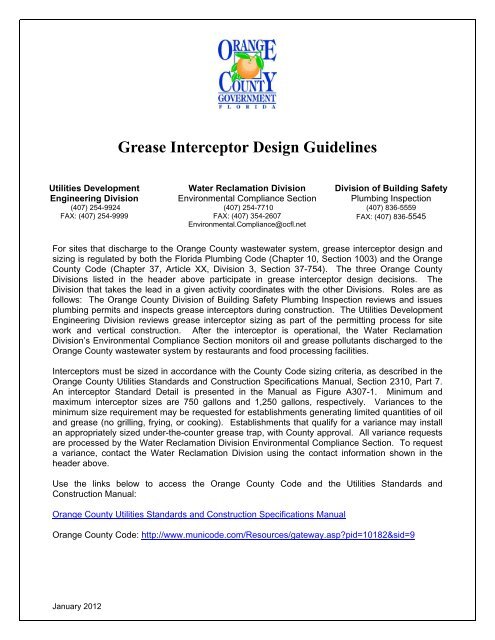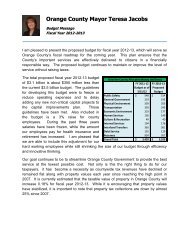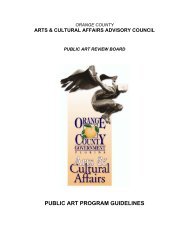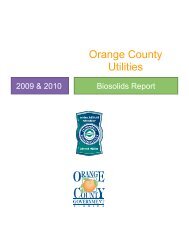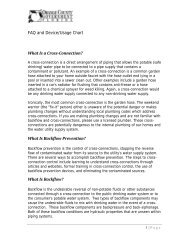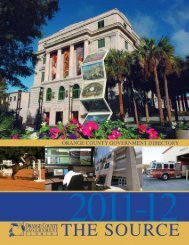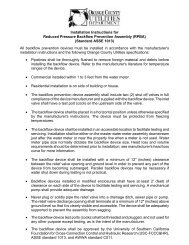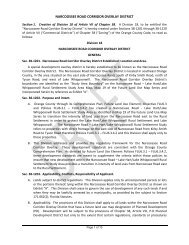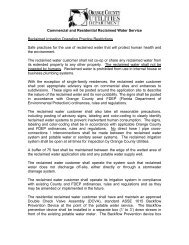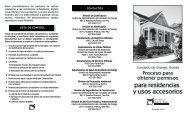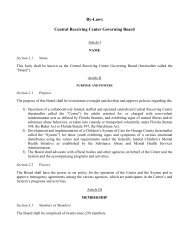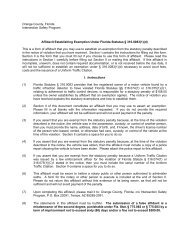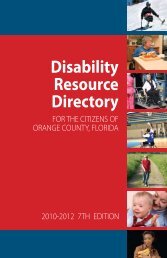Grease Interceptor Design Guidelines
Grease Interceptor Design Guidelines
Grease Interceptor Design Guidelines
Create successful ePaper yourself
Turn your PDF publications into a flip-book with our unique Google optimized e-Paper software.
<strong>Grease</strong> <strong>Interceptor</strong> <strong>Design</strong> <strong>Guidelines</strong><br />
Utilities Development<br />
Engineering Division<br />
(407) 254-9924<br />
FAX: (407) 254-9999<br />
Water Reclamation Division<br />
Environmental Compliance Section<br />
(407) 254-7710<br />
FAX: (407) 354-2607<br />
Environmental.Compliance@ocfl.net<br />
Division of Building Safety<br />
Plumbing Inspection<br />
(407) 836-5559<br />
FAX: (407) 836-5545<br />
For sites that discharge to the Orange County wastewater system, grease interceptor design and<br />
sizing is regulated by both the Florida Plumbing Code (Chapter 10, Section 1003) and the Orange<br />
County Code (Chapter 37, Article XX, Division 3, Section 37-754). The three Orange County<br />
Divisions listed in the header above participate in grease interceptor design decisions. The<br />
Division that takes the lead in a given activity coordinates with the other Divisions. Roles are as<br />
follows: The Orange County Division of Building Safety Plumbing Inspection reviews and issues<br />
plumbing permits and inspects grease interceptors during construction. The Utilities Development<br />
Engineering Division reviews grease interceptor sizing as part of the permitting process for site<br />
work and vertical construction. After the interceptor is operational, the Water Reclamation<br />
Division’s Environmental Compliance Section monitors oil and grease pollutants discharged to the<br />
Orange County wastewater system by restaurants and food processing facilities.<br />
<strong>Interceptor</strong>s must be sized in accordance with the County Code sizing criteria, as described in the<br />
Orange County Utilities Standards and Construction Specifications Manual, Section 2310, Part 7.<br />
An interceptor Standard Detail is presented in the Manual as Figure A307-1. Minimum and<br />
maximum interceptor sizes are 750 gallons and 1,250 gallons, respectively. Variances to the<br />
minimum size requirement may be requested for establishments generating limited quantities of oil<br />
and grease (no grilling, frying, or cooking). Establishments that qualify for a variance may install<br />
an appropriately sized under-the-counter grease trap, with County approval. All variance requests<br />
are processed by the Water Reclamation Division Environmental Compliance Section. To request<br />
a variance, contact the Water Reclamation Division using the contact information shown in the<br />
header above.<br />
Use the links below to access the Orange County Code and the Utilities Standards and<br />
Construction Manual:<br />
Orange County Utilities Standards and Construction Specifications Manual<br />
Orange County Code: http://www.municode.com/Resources/gateway.asp?pid=10182&sid=9<br />
January 2012


